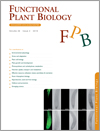
Functional Plant Biology
Volume 46 Number 2 2019
This review provides novel insights into the treatment of rheumatoid arthritis. Total glucosides of paeony (TGP) and paeoniflorin (Pae) inhibit lymphocyte proliferation; repress the activation of macrophages, monocytes and fibroblast-like synoviocytes (FLSs); decrease prostaglandin E2; upregulate E-prostanoid-G-protein-cyclic adenosine monophosphate and blockade the mitogen-associated-protein kinases pathway in FLSs. These results provide the basic and clinical application of TGP and Pae.
FP18156Two molecular species of phytochrome A with distinct modes of action
Phytochrome A – the key photoreceptor in the higher plants – mediates three fundamental types of their photoregulation reactions. It is widely accepted that it is represented in plants as a single molecular species. This review presents an alternative point of view: the existence of two phytochrome A types differing by the molecular structure and mode of action.
The roles of hydrogen sulfide (H2S) and hydrogen peroxide (H2O2) during salt stress-induced stomatal closure were examined in Vicia faba L. Our data showed that H2S and H2O2 are involved in salt stress-induced stomatal closure, and H2S may function downstream of H2O2 in the process. We have provided direct evidence for further studies on stomatal movement signalling networks under salt stress.
Plants absorb CO2 through pores in their leaves called stomata, which are known to open and close in response to myriad environmental and physiological triggers. We demonstrate here that blue light inhibits stomatal aperture oscillations in both the guard cells and surrounding tissue layers, whereas these oscillations continue under the influence of red light. This observation of blue light behaviour agrees with recent research and suggests another physiological pathway for oscillations.
FP18074DNA synthesis pattern, proteome, and ABA and GA signalling in developing seeds of Norway maple (Acer platanoides)

Norway maple embryo (axis and cotyledons) development was studied, including DNA synthesis, proteins, and plant hormone signalling. Results revealed that cell cycle/endoreduplication activity is a good indicator of developmental stages, distinguishing maturation phases, including deposition of storage reserves, desiccation and dormancy acquisition. Our results provide novel insights into the mechanisms underlying the development of temperate tree seeds.
Reactive oxygen species (ROS) are important regulators of ABA signalling in root growth. This work aimed to explore the mechanisms of PERK4-associated ABA inhibition of root growth. Our results provided new perspectives that enhance our understanding of the process, and provided a foundation for elucidation of the molecular mechanisms of PERK4-mediated ABA-regulated primary root growth.
FP18203Costs and benefits of photosynthetic stems in desert species from southern California
Woody plants with green stems are common in the drylands of the world; however, the advantages of having such stems (e.g. extra carbon gain) may be offset by water costs. We found that green stems can gain as much carbon as leaves do but are subjected to greater water losses through their cuticle. This trade-off between carbon gain and water loss has important implications for plant responses to future droughts.
FP17216MdMYBL2 helps regulate cytokinin-induced anthocyanin biosynthesis in red-fleshed apple (Malus sieversii f. niedzwetzkyana) callus
 , Jingjing Sun, Nan Wang, Haifeng Xu, Changzhi Qu, Shenghui Jiang, Hongcheng Fang, Mengyu Su, Zongying Zhang and Xuesen Chen
, Jingjing Sun, Nan Wang, Haifeng Xu, Changzhi Qu, Shenghui Jiang, Hongcheng Fang, Mengyu Su, Zongying Zhang and Xuesen Chen
During the cultivation of fruit trees, the rational application of hormones based on different environmental conditions can improve the appearance and nutritional value of fruit crops. Herein, we discussed the involvement of cytokinin in the anthocyanin biosynthesis pathway, which may have implications for the development of new cultivation techniques aimed at improving fruit coloration under diverse environmental conditions.




